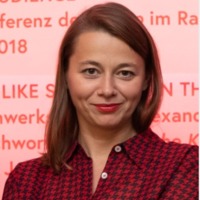- Österreichische Galerie Belvedere, Curatorial Department, Department Memberadd
- Luisa Ziaja is an art historian, curator, university lecturer, and writer. She has been curator for contemporary art ... moreLuisa Ziaja is an art historian, curator, university lecturer, and writer. She has been curator for contemporary art at the Österreichische Galerie Belvedere Vienna since 2013 and co-director of the postgraduate program in exhibition theory and practice ecm – educating / curating / managing at the University of Applied Arts Vienna since 2006. In her curatorial and discursive practice, she deals with the relation between contemporary art, society, and politics (of history) as well as with the histories and theories of exhibiting. She is the author and coeditor of numerous exhibition catalogs as well as anthologies on contemporary art, curating, and art and exhibition theory, among others the publishing series curating. ausstellungstheorieedit
1990, vor inzwischen dreißig Jahren, publizierte Rosalind Krauss in der Herbstausgabe der Kunstzeitschrift October ihren einflussreichen Essay »The Cultural Logic of the Late Capitalist Museum«. Er beruht auf Beobachtungen und... more
1990, vor inzwischen dreißig Jahren, publizierte Rosalind Krauss in der Herbstausgabe der Kunstzeitschrift October ihren einflussreichen Essay »The Cultural Logic of the Late Capitalist Museum«. Er beruht auf Beobachtungen und Begegnungen, die Krauss miteinander verknüpft, um die zunehmende Kommodifizierung und Korporatisierung von Kunstwerken, öffentlichen Sammlungen und Museen am Ende des 20. Jahrhunderts zu analysieren. Mit Fredric Jameson, dessen Aufsatz »Postmodernism, or The Cultural Logic of Late Capitalism« Krauss im Titel referenziert, zeichnet sie paradigmatische Verschiebungen im musealen Feld und in der Ausstellungspraxis nach: Neuerdings erscheine es legitim, so Krauss, Objekte in einem Museumsbestand als »Vermögenswerte« zu bezeichnen – die Wahrnehmung einer Sammlung als kulturelles Erbe und unersetzliche Verkörperung kulturellen Wissens werde abgelöst von jener als Kapital, vergleichbar etwa mit Aktienpaketen. Dieses Primat des Ökonomischen im Museum äußere sich in der »Unternehmenskultur«, in den Haupteinnahmequellen und nicht zuletzt in der Zusammensetzung der mächtigen Kuratorien. Die Krise der Museumsgesellschaft sei demnach weitgehend ein Resultat der marktwirtschaftlichen Orientierung der 1980er-Jahre. Die Vorstellung vom Museum als Sachwalter des öffentlichen Erbes sei der Vorstellung vom Museum als Unternehmen mit sehr gut vermarktbaren Beständen und mit Expansionsgelüsten gewichen.
Research Interests:
Research Interests:
Research Interests:
The Museum of the Future, edited by Gerhard Bott, offers new perspectives on the museum. It was time to leave behind the notion of the museum as an ivory tower of science, as a place where items in collections were merely inventoried and... more
The Museum of the Future, edited by Gerhard Bott, offers new perspectives on the museum. It was time to leave behind the notion of the museum as an ivory tower of science, as a place where items in collections were merely inventoried and studied in terms of their cultural and art historical value. It was time for something new. It was time for the museum to (re)establish its relationship to society and to take on the role of an educational institution. In her book La Fin des Musees, Catherine Grenier, codirector of Centre Pompidou, challenges the discourse pointing to the “end of the museum”. Similar to her predecessors in the 1970s, she argues the museum needs to be understood as a current institution, whose interests do not only revolve around itself but as one that actively engages with urgent questions concerning our world and society today. What would happen if the “museum of the future” were a para-museum? What would it be like? If we conceive of the para-museum as something that is simultaneously inside and outside and in a parasitic relationship to the museum, then a form of subversion may just cross our minds—one that robs the museum (of its power to endow meaning and definitions and its infrastructure). Insofar that the para-museum maintains its relation to the museum with its potential for change and its relation to social struggles that disrupt logics behind hegemonic claims to power, it remains simultaneously part of the museum and part of a different order, one that is perhaps yet to come.
Research Interests:
The Museum of the Future, edited by Gerhard Bott, offers new perspectives on the museum. It was time to leave behind the notion of the museum as an ivory tower of science, as a place where items in collections were merely inventoried and... more
The Museum of the Future, edited by Gerhard Bott, offers new perspectives on the museum. It was time to leave behind the notion of the museum as an ivory tower of science, as a place where items in collections were merely inventoried and studied in terms of their cultural and art historical value. It was time for something new. It was time for the museum to (re)establish its relationship to society and to take on the role of an educational institution. In her book La Fin des Musees, Catherine Grenier, codirector of Centre Pompidou, challenges the discourse pointing to the “end of the museum”. Similar to her predecessors in the 1970s, she argues the museum needs to be understood as a current institution, whose interests do not only revolve around itself but as one that actively engages with urgent questions concerning our world and society today. What would happen if the “museum of the future” were a para-museum? What would it be like? If we conceive of the para-museum as something that is simultaneously inside and outside and in a parasitic relationship to the museum, then a form of subversion may just cross our minds—one that robs the museum (of its power to endow meaning and definitions and its infrastructure). Insofar that the para-museum maintains its relation to the museum with its potential for change and its relation to social struggles that disrupt logics behind hegemonic claims to power, it remains simultaneously part of the museum and part of a different order, one that is perhaps yet to come.
